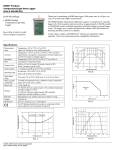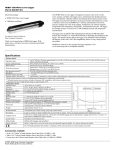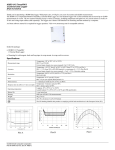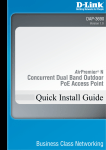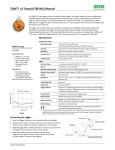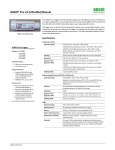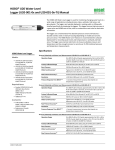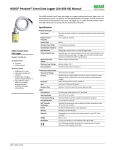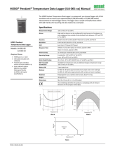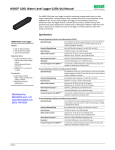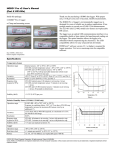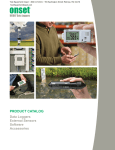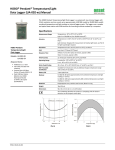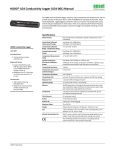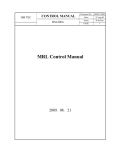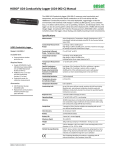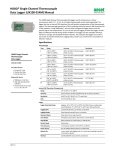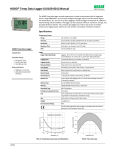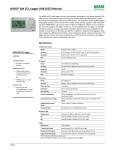Download HOBO Dissolved Oxygen Logger (U26-001) Manual
Transcript
HOBO® Dissolved Oxygen Logger (U26-001) Manual The HOBO Dissolved Oxygen logger is a standalone logger that uses RDO® Basic Technology to measure dissolved oxygen (DO). The logger has an optical sensor that provides 0.2 mg/L accuracy. The logger also features an easily replaceable sensor cap and an integrated temperature sensor. Using HOBOware® software for logger setup and a HOBO Waterproof Shuttle for quick data offload, this logger is easy to deploy in both freshwater and saltwater environments making it an ideal tool for environmental impact studies as well as ecological and oceanographic research. Using the data offloaded from the logger, the HOBOware Dissolved Oxygen Assistant can calculate percent saturation and salinity-adjusted DO concentration as well as correct for measurement drift from fouling. HOBO Dissolved Oxygen Logger with Included Calibration Boot and Sponge (Shown Wet in Photo) Specifications Dissolved Oxygen HOBO Dissolved Oxygen Logger Sensor Type Optical (dynamic luminescence quenching) Measurement Range 0 to 30 mg/L U26-001 Calibrated Range 0 to 20 mg/L; 0 to 35°C (32 to 95°F) Accuracy 0.2 mg/L up to 8 mg/L; 0.5 mg/L from 8 to 20 mg/L Resolution 0.02 mg/L Response Time To 90% in less than 2 minutes DO Sensor Cap Life 6 months (cap expires 7 months after initialization) Included Items: • Dissolved Oxygen Sensor Cap • Protective Guard • Calibration Boot and Sponge Required Items: • Coupler (COUPLER-2-C) with USB Optic Base Station (BASE-U-4) or HOBO Waterproof Shuttle (U-DTW-1) • HOBOware Pro 3.3.1 or later Accessories: • Replacement Dissolved Oxygen Sensor Cap (U26-RDOB-1) • Anti-Fouling Guard (U26-GUARD-2) • Sodium Sulfite (U26-CAL-SOL) You May Also Need: • For saltwater, salinity or conductivity measurements are required; HOBO Conductivity/Salinity Logger (U24-002) recommended • For percent saturation, barometric pressure is required; HOBO Water Level Logger (U20-001-0x) recommended Temperature Temperature Measurement/ Operating Range -5 to 40°C (23 to 104°F), non-freezing Temperature Accuracy 0.2°C (0.36°F) Temperature Resolution 0.02°C (0.04°F) Response Time To 90% in less than 30 minutes Logger Memory 21,700 sets of DO and temperature measurements (64 KB total memory); logging stops when memory fills Logging Rate 1 minute to 18 hours Time Accuracy ±1 minute per month at 0 to 50°C (32 to 122°F) (see Plot A on next page) Battery 3.6 V lithium battery; factory replaceable Battery Life 3 years (at 5 minute logging) Download Type Optical Depth Rating 100 m (328 ft) Wetted Materials Black Delrin®, PVC, EPDM o-rings, silicon bronze screws; rated for saltwater use Size 39.6 mm diameter x 266.7 mm length (1.56 x 10.5 inches) Weight 464 g (16.37 oz) The CE Marking identifies this product as complying with all relevant directives in the European Union (EU). 15603-A MAN-U26x Distributed by MicroDAQ.com, Ltd. www.MicroDAQ.com (603) 746-5524 HOBO Dissolved Oxygen Logger (U26-001) Manual Specifications (continued) WARNING: This logger can be damaged by mechanical shock. Always handle the logger with care. The logger may be damaged if it is dropped. Use proper packaging when transporting or shipping the logger. Do not attempt to open the logger case or sensor housing. Disassembling of the logger case or sensor housing will cause serious damage to the sensor and logger electronics. There are no user-serviceable parts inside the case. Contact Onset Technical Support at 1-800-LOGGERS (1-800-564-4377) or an authorized Onset dealer if your logger requires servicing. Installing the Sensor Cap Plot A: Time Accuracy The logger ships with a replaceable sensor cap that provides six months of continuous use. Once the cap is initialized, an internal clock within the logger will count down until the sensor cap expiration date. When the sensor cap expires, you will need to replace it with a new cap (U26-RDOB-1). The sensor cap is intended for six months of actual deployment, but the expiration date is seven months from the date the cap was initialized. This allows for any time needed between launching the logger and physically deploying as well as extra time in case you are not able to get the logger after exactly six months of deployment. To install the sensor cap: Logger Components and Operation Communications Cap/Lanyard Temperature Sensor (Inside Logger Housing) Protective Guard Mounting Hole Alignment Notch for Coupler 1. Unscrew the protective guard covering the DO sensor (see diagram at left). 2. Remove the red dust cap that protects the sensor during shipping. DO Sensor 3. Take the green sensor cap out of the canister. 4. With the flat part of the DO sensor pointing down and the the green sensor cap oriented with the arrow up, slide the sensor cap over the sensor until it snaps in place. The cap should be snug against the logger housing without any gaps. Communications Cap/Lanyard. This removable cap protects the optical communications window. An LED in the communications window of the logger confirms logger operation. When the logger is logging, the LED blinks once every four seconds. The LED also blinks when the logger is recording a sample. When the logger is awaiting a start because it is configured to start “At Interval,” “On Date/Time,” or “Using Coupler,” the LED blinks once every eight seconds until logging begins. See Connecting the Logger to a Computer or Waterproof Shuttle for details on using the communications window. Sensor cap with arrow positioned up; slide over DO sensor until it snaps in place Mounting Hole. Use the hole on the communications cap to mount the logger. See Deploying the Logger for more information. DO sensor, flat side down Alignment Notch for Coupler. Use this notch to align the coupler when communicating with the logger. See Connecting the Logger to a Computer or Waterproof Shuttle for more information. 5. Screw the external protective guard back on until tight. DO Sensor. This optical sensor measures dissolved oxygen using RDO® Basic Technology. It is shipped with a red dust cap that must be replaced with a green sensor cap that lasts for six months plus a one-month grace period. See Installing the Sensor Cap for more details. Important: The sensor cap expires seven months (to the day) after it has been initialized and the logger will not collect any data after the cap has expired. Initialization occurs automatically when the cap is installed after the logger is launched. You can also initialize it from the Status window in HOBOware or when using the Lab Calibration tool. To see when the sensor cap expires after being initialized, check the Status in HOBOware for the expiration date. The cap also has a shelf life; check the “Install By” date printed on the canister. Protective Guard. This removable guard protects the DO sensor. Unscrew it to install or replace the sensor cap as needed. See Installing the Sensor Cap for more details. Temperature Sensor. This built-in sensor (not visible in diagram) measures temperature. 1-800-LOGGERS Distributed by MicroDAQ.com, Ltd. 2 www.MicroDAQ.com www.onsetcomp.com (603) 746-5524 HOBO Dissolved Oxygen Logger (U26-001) Manual Connecting the Logger to a Computer or Waterproof Shuttle Calibrating the Logger with the Lab Calibration Tool To connect the logger to a computer, use either the Optic USB Base Station (BASE-U-4) or HOBO Waterproof Shuttle (U-DTW1) with a coupler (COUPLER2-C). To launch and read out the logger in the field, use one of these three methods: Use the Lab Calibration tool in HOBOware when you need to calibrate the logger before deploying it or after replacing an expired sensor cap. The tool sets the gain and offset adjustment values for the logger by: • Laptop computer with Optic USB Base Station (BASE-U-4) and coupler (COUPLER2-C) • Restoring logger calibration values to the factory defaults, • HOBO Waterproof Shuttle (U-DTW-1, Firmware Version 3.2.0 or later) and coupler (COUPLER2-C) • Using your own gain and offset adjustment values, or • Calculating the values with a three-step calibration procedure. • HOBO U-Shuttle (U-DT-1, Firmware Version 1.16 or later) with Optic USB Base Station and coupler (COUPLER2-C) In the three-step procedure, the logger is first calibrated to 100% saturation by placing it in water-saturated air. Then, you can calibrate the logger to 0% saturation by placing it in sodium sulfite or another 0% oxygen environment (recommended if the logger will be deployed in water with DO levels of 4 mg/L or less). IMPORTANT: USB 2.0 specifications do not guarantee operation outside the range of 0°C (32°F) to 50°C (122°F). 1. Follow the instructions that came with your base station or Waterproof Shuttle to attach it to a USB port on the computer. IMPORTANT: Lab calibration only affects future launches; any data saved in the logger will be based on the previous calibration values. If the sensor cap is installed and it has not yet been initialized, you will be prompted to do so. Follow the instructions on the screen. 2. Unscrew the pointed cap on the communications end of the logger. 3. Attach the coupler to the base station or shuttle. To complete these steps, you will need fresh water, the calibration boot and sponge supplied with the logger, and a source for current barometric pressure at your current location. You will also need sodium sulfite solution and a 7.6 cm (3 inch) beaker if you will be calibrating to 0% saturation. 4. Insert the logger into the coupler, aligning the bump/arrow on the coupler with the notches on the logger. Be sure that it is properly seated in the coupler. If the logger has never been connected to the computer before, it may take a few seconds for the new hardware to be detected by the computer. Note: If you are using the HOBO Waterproof Shuttle as a base station with a computer, briefly press the coupler lever to put the shuttle into base station mode. A green LED on the shuttle or base station indicates good communication. The fresh water, logger, and sodium sulfite (if applicable) should be left out in the lab where the calibration is being done long enough so that they are at room temperature. If the logger was deployed previously, make sure the sensor is clean and dry (see Maintenance for more details). To use the Lab Calibration tool: 1. Connect the logger to the computer as described in the previous section. Stop the logger if it is currently logging or awaiting a coupler or delayed start. Notches in logger; use to align with bump in coupler 2. From the Device menu, click Lab Calibration. Bump on coupler 3. The current gain and offset adjustments are displayed in the top pane of the Lab Calibration window along with the date and time the last lab calibration was completed (if applicable). Completing Steps 1 through 3 in the Lab Calibration tool will result in new gain and offset adjustment values based on the current logger conditions. Continue to the next section for details on how to complete these steps. Communications end of logger To base station or shuttle Coupler lever 5. After logger communications are complete, remove the logger from the coupler. Make sure the o-ring is still in the groove inside the cap and then reinstall the communications cap. If you already know what the gain and offset values should be (for example, the values from a previous calibration that you want to use again) or want to return to the default factory values, click the “I know my values, skip to Finish” button. This will automatically move you to “Step 3: Finish” in the Lab Calibration window. Either click the “Reset to Factory Defaults” button or type in the desired gain adjustment and offset adjustment values and click the “Send Calibration to the Logger” button. Note: If you decide you do not need to change the calibration, click Close to cancel the calibration and revert back to the last saved logger values. IMPORTANT: When connected to a coupler, the logger is “awake” and consumes significantly more power than when it is disconnected and considered “asleep.” The logger will automatically “go to sleep” after being left in the coupler for 30 minutes. It will no longer appear as a USB device connected to the computer. If this occurs, remove it from the coupler and start the instructions to connect the logger to a computer or waterproof shuttle over again. 1-800-LOGGERS Distributed by MicroDAQ.com, Ltd. 3 www.MicroDAQ.com www.onsetcomp.com (603) 746-5524 HOBO Dissolved Oxygen Logger (U26-001) Manual Step 1: 100% Saturation button click, then temperature equilibrium has likely been reached. 1. In “Step 1: 100% Saturation” in the Lab Calibration window, enter the barometric pressure for your current location. If the barometric pressure reading has been adjusted for sea level (such as a reading taken from the National Weather Service weather station), select the “If using sea level barometric pressure, enter elevation” checkbox and enter your elevation in either meters or feet. 6. When you are satisfied with the results displaying in the “Step 2: 0% Saturation” tab, click the Next button to proceed to “Step 3: Finish.” Step 3: Finish The results from the first two steps are displayed as well as the overall calibration results and the new gain and offset adjustment values. If you are satisfied with the results, click the “Send Calibration to Logger” button. The logger will then be calibrated based on the new values. These values will not take effect until the logger is launched. If you do not want to save these values, click Close to cancel the calibration and revert back to the last saved logger values. Or, click “Reset to Factory Defaults” to return to the original values. If you performed Step 2, then remove the logger from the solution and thoroughly rinse it with fresh water to remove any excess sodium sulfite. See Maintenance for additional details on cleaning the logger. 2. Make sure the logger either has the protective guard or the anti-fouling guard installed (whichever guard you plan to use in the deployment) so that the sensor is covered. 3. Wet the small sponge with fresh water. Squeeze out any excess water. 4. Place the sponge in the end of the calibration boot. 5. Insert the logger in the calibration boot so that there is approximately a 1 cm (0.5 inch) overlap between the end of the boot and the body of the logger. This will ensure there is enough space between the end of the logger and the sponge (the logger should not be pressed up tightly against the sponge). Launching the Logger After calibrating the logger, it needs to be launched to configure it before taking it to the field for deployment. Once launched, the logger will record two types of data: samples and events. Samples are the sensor measurements recorded at each logging interval. Events are independent occurrences triggered by a logger activity, such as Bad Battery or Host Connected. Events help you determine what was happening while the logger was logging. To launch the logger: 6. Wait for approximately 15 minutes until the logger reaches temperature equilibrium (and less than 30 minutes so the logger does not go to sleep). 7. Click the “Get DO value from the logger” button to display the 100% saturation results. You can click this button as often as needed. The results are updated each time you click the button. To check for equilibrium, click the “Get DO value from the logger” button several times in a row to check the current “DO Conc from logger at 100% Saturation” value. If the value remains the same or varies very little with each button click, then temperature equilibrium has likely been reached. 1. With the logger connected to the computer, open HOBOware. From the Device menu, select Launch. 2. Select both the DO and Temperature channels to log. Note: HOBOware provides the option of recording the current battery voltage at each logging interval, which is disabled by default. Recording battery life at each logging interval takes up memory and therefore reduces logging duration. It is recommended that you only record battery voltage for diagnostic purposes. Even with the channel disabled, a bad battery event will still be recorded. 8. When you are satisfied with the results displaying in the “Step 1: 100% Saturation” tab, click the Next button to proceed to “Step 2: 0% Saturation.” Step 2: 0% Saturation (optional) If the logger will be deployed in water with DO levels greater than 4 mg/L, click the “Skip this Step” button. Otherwise, continue with the following procedure. 3. Select a logging interval. 4. Choose when to start logging and click the Start button. 1. Make sure the logger either has the protective guard or the anti-fouling guard installed (whichever guard you plan to use in the deployment) so that the sensor is covered. 5. Remove the logger from the coupler and screw the communications cap back on the logger. IMPORTANT: If this is the first launch with a new sensor cap, the sensor cap will expire six months (plus a one-month grace period) from the time of the first sensor reading. Two caps per year are required for year-round deployment. 2. Pour the sodium sulfite into the beaker so that it is about two-thirds full. 3. Place the sensor end of the logger into the solution so that the entire protective guard or anti-fouling guard and at least 2.5 cm (1 inch) of the logger body are submerged in the beaker. Allow it to rest on the bottom of the beaker. Deploying the Logger The logger is designed to be easy to deploy in many environments. Follow these guidelines when deploying it: 4. Wait for approximately 15 minutes until the logger reaches temperature equilibrium (and less than 30 minutes so the logger does not go to sleep). • Remove the calibration boot before deploying the logger. • Make sure the logger is located where it will receive an unrestricted flow of the water being monitored to the sensor. 5. Click the “Get DO value from the logger” button to display the 0% saturation results. As with the 100% calibration, you can click this button as often as needed. The results are automatically updated each time you click the button. If the value remains the same or varies very little with each 1-800-LOGGERS Distributed by MicroDAQ.com, Ltd. 4 www.MicroDAQ.com www.onsetcomp.com (603) 746-5524 HOBO Dissolved Oxygen Logger (U26-001) Manual • Make sure the logger is fully submerged and not in direct sunlight to minimize temperature changes that are unrelated to water temperature. meter or by titration. If using a meter, make sure it is calibrated and allow time for the meter probe to stabilize (this will occur when three meter measurements taken in a row are within your accuracy tolerance). • When deploying the logger in rivers, streams, and ponds, insert the logger in a PVC or ABS pipe for protection from debris (if possible). The pipe should have enough holes to ensure good circulation of water to the sensor. If the logger is being deployed in saltwater, adjust the meter measurements for salinity using a meter with both conductivity and DO probes. If the saltwater has a constant salinity, you can use a DO meter where you can enter that salinity value to adjust the readings. If the salinity and/or DO are changing rapidly, then you will need to get a sample of the water in a container large enough for both the logger and meter probe to be completely submerged. Place both devices in the water long enough for them to stabilize and then for the DO logger to log at least two values, and take a concurrent meter reading. • If possible, position the logger so the sensor face is oriented vertically. After deploying in the water, move the logger around slightly to eliminate any bubbles that may have formed. • Do not deploy the logger in freezing water with moving ice where the logger could be crushed. • Use the optional anti-fouling guard to protect against fouling. Unscrew the protective guard and replace it with the anti-fouling guard. 2. Record the reading, date, and time of the measurement in a field notebook. • If fouling is expected during deployment, use field calibration readings from both the beginning and end of the deployment as described in the next section. These readings can then be entered into the HOBOware Dissolved Oxygen Assistant to compensate for any measurement drift due to fouling. Scrub fouling off the logger with a plastic bristle brush. 3. At the end of the deployment, repeat steps 1 and 2. • When deploying the logger in saltwater, you will need a conductivity value to enter in the Dissolved Oxygen Assistant that adjusts the data from the logger for salinity. If the salinity is constant through the deployment, you will need a single salinity reading from either a conductivity meter or salinometer. However, if the conductivity changes, then you will need a data file with salinity or specific conductivity readings for the entire deployment. Consider deploying a HOBO Conductivity logger (U24-002) next to this DO logger to use the resulting data file for salinity data. 2. If the logger has been in salt water, clean the logger body and sensor cap as described in the Maintenance section. Make sure the sensor cap is dry before continuing. To Take Calibration Readings Using 100% Water-Saturated Air: 1. The logger must be logging. You will need fresh water, the included calibration boot and sponge, and the current barometric pressure from a HOBO U20 Water Level logger, a barometer, or a nearby weather station. 3. Make sure the protective guard or anti-fouling guard is installed on the logger. 4. Wet the small sponge with fresh water. Squeeze out any excess water. 5. Place the sponge in the end of the calibration boot. 6. Insert the logger in the calibration boot so that there is approximately a 1 cm (0.5 inch) overlap between the end of the boot and the body of the logger. This will ensure there is enough space between the end of the logger and the sponge (the logger should not be pressed up tightly against the sponge). • To generate a percent saturation series, you will need to deploy a barometric pressure logger (such as a HOBO Water Level Logger, U20-001-0x) or have access to a nearby weather station to gather barometric pressure data. This data is necessary for the Dissolved Oxygen Assistant to calculate percent saturation. 7. Allow at least 40 minutes for the logger to reach temperature equilibrium, and then write down the date and time in a field notebook. Taking Field Calibration Readings If fouling is expected during the deployment, you can take calibration readings at the beginning and end of the deployment to enter in the Dissolved Oxygen Assistant. This will adjust the data from the logger to compensate for any measurement drift due to fouling. There are two methods for taking field calibration readings: the first method involves taking readings using a dissolved oxygen meter or titration while the second method involves calibrating the logger in 100% water-saturated air. The first method is recommended because it is quicker to get the necessary calibration readings; the second method can take 40 minutes or more to achieve equilibrium with temperature extremes. 8. Write down the barometric pressure at that time (note the elevation if the barometric reading has been adjusted for sea level). To Take Calibration Readings Using a DO Meter or Titration: 2. If the logger was in saltwater and you did not deploy a HOBO Conductivity Logger, then use a conductivity meter or salinometer to take a conductivity reading. Write down the reading and the date and time. 9. Repeat these steps at the end of the deployment. Reading Out the Logger and Redeploying Your readout and maintenance schedule will be determined by the amount of fouling at the site. To read out the logger in the field: 1. Take a field calibration reading as described in the Taking Field Calibration Readings section. 1. The logger must be logging. Take a DO measurement of the water where the logger is being deployed using either a DO 1-800-LOGGERS Distributed by MicroDAQ.com, Ltd. 5 www.MicroDAQ.com www.onsetcomp.com (603) 746-5524 HOBO Dissolved Oxygen Logger (U26-001) Manual 3. Remove the logger from the water and read out the data from the logger using a shuttle or computer with a base station. 4. If you are deploying it again, clean the sensor (see Maintenance for details). 5. Check the expiration date for your cap and make sure it will not expire before the end of your deployment. Replace it if needed. 6. Relaunch the logger if it is not already logging. 7. Take another field calibration reading after the logger is cleaned. 8. Redeploy the logger. deployments, keep it in the calibration boot (wet the small sponge with fresh water, place the sponge in the end of the calibration boot, and then insert the logger in the boot.) WARNING: Do not use organic solvents; they will damage the sensor. Do not remove the sensor cap from the sensor prior to cleaning with a brush. Only clean the sensor when you replace the sensor cap. See the full instructions that ship with the replacement sensor cap. Do not wet the sensor optical lens area with water or any solution. Remove the cap and gently wipe the window with a soft cloth. To clean the logger body: 1. Make sure the sensor cap is installed on the logger. Using the HOBOware Dissolved Oxygen Assistant 2. Gently scrub the logger body with a plastic bristle brush or nylon dish scrubber. Use the Dissolved Oxygen Assistant to obtain accurate Dissolved Oxygen readings if the logger was deployed in a saltwater environment or if percent saturation is required. Also use this assistant if you took field calibration readings. The Dissolved Oxygen Assistant is only available in HOBOware from the Plot Setup window when you open a file from this logger. To use the assistant: 3. Use Alconox® to remove grease. 1. Offload the most recent data files from the shuttle or logger to your computer. 2. Open a data file in HOBOware. 3. In the Plot Setup window, select the Dissolved Oxygen Assistant and click Process. 4. In the Dissolved Oxygen Assistant window, enter the salinity, barometric pressure, and field calibration information as needed. Click the Help button in the Dissolved Oxygen Assistant for more details and to learn about the ranges of input data allowed. 5. Plot the data and save it as a project file. Maintenance To clean the sensor cap: 1. Remove the protective guard or anti-fouling guard, but leave the sensor cap on the sensor. 2. Rinse the logger with clean water from a squirt bottle or spray bottle. 3. Gently wipe the cap with a soft-bristled brush (such as a toothbrush) or soft cloth if biofouling is present. Use Alconox® to remove grease. 4. If extensive debris or mineral build-up is present, soak the cap end in vinegar for 15 minutes, then soak it in deionized (DI) water for another 15 minutes. 5. If the logger is being immediately redeployed with the same sensor cap, a field calibration is adequate. If a new sensor cap is being installed, a lab calibration with HOBOware is recommended. When storing the logger between 1-800-LOGGERS (564-4377) • 508-759-9500 www.onsetcomp.com • [email protected] 4. Soak in vinegar to remove mineral deposits. 5. Rinse the logger with deionized (DI) water. Battery Guidelines The battery life of the logger should be three years or more. Actual battery life is a function of the number of deployments, logging interval, and operation/storage temperature of the logger. Frequent deployments with fast logging intervals, continuous storage/operation at temperatures above 35°C (95°), and keeping the logger connected to the coupler will result in significantly lower battery life. For example, the battery may last less than a year with a 1-minute logging interval. To obtain a three-year battery life, a logging interval of five minutes or greater should be used and the logger should be operated and stored at temperatures between 0° and 25°C (32° and 77°F). The logger can report and log its battery voltage. If the battery falls below 3.2 V, the logger will record a “bad battery” event in the datafile. The logger will record a second “bad battery” event and stop logging when the battery falls below 3.1 V. If the datafile contains “bad battery” events, the logger should be returned to Onset for battery replacement. Note the logger does not have to be recording the battery channel for it to detect bad battery events. The logger will record these events regardless of what channels are logged. To have your logger’s battery replaced, contact Onset or your place of purchase for return arrangements. Do not attempt to replace the battery yourself. Severe damage to the logger will result if the case is opened without special tools, and the warranty will be voided. WARNING: Do not cut open, incinerate, heat above 100°C (212°F), or recharge the lithium battery. The battery may explode if the logger is exposed to extreme heat or conditions that could damage or destroy the battery case. Do not dispose of the logger or battery in fire. Do not expose the contents of the battery to water. Dispose of the battery according to local regulations for lithium batteries. © 2012 Onset Computer Corporation. All rights reserved. Onset, HOBO, and HOBOware are trademarks or registered trademarks of Onset Computer Corporation. RDO is a registered trademark of In-Situ® Inc., Fort Collins, CO USA. All other trademarks are the property of their respective companies. 15603-A MAN-U26x Distributed by MicroDAQ.com, Ltd. www.MicroDAQ.com (603) 746-5524






